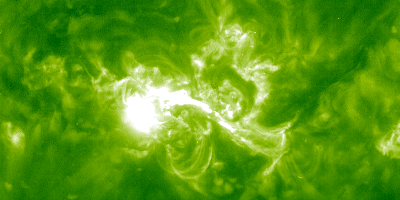 Second gigantic flare erupts from the sun October 31, 2003
"It's like the Earth is looking right down the barrel of a giant gun pointed at us by the Sun...and it's taken two big shots at us," says John Kohl, a solar astrophysicist at the Harvard-Smithsonian Center for Astrophysics (CfA) and principal investigator for the Ultraviolet Coronagraph Spectrometer on board NASA's Solar and Heliospheric Observatory (SOHO) spacecraft. "The Sun is really churned up right now. The timing of two very large X-class flares aimed directly at the Earth, occurring one right after another, is unprecedented," says Kohl. " I have not seen anything like it in my entire career as a solar physicist. The probability of this happening is so low that it is a statistical anomaly." As the faster moving particles from the second eruption catch up to the slower moving particles from the first eruption - the combined effect cannot be predicted. Kohl reflects, "This second blast is moving like a fast freight train that very soon will plow into the back of the slower moving freight train in front of it as they both pull into the station at the same time. The station in this case happens to be the planet Earth." The two combined eruptions are creating a geomagnetic storm, which could influence the Earth in a number of ways, including disrupting satellite communications and power grids. However, precautions already have been taken to minimize the potential impact. For example, power companies have reduced the line loads to allow leeway for possible surges. People on the ground are well protected from the ongoing geomagnetic storm due to the Earth's natural shielding. Pacemakers and similar devices are not affected. Airline travel also is safe, since the Earth's magnetosphere and atmosphere block the solar radiation. The web site space.com reports that the astronauts aboard the International Space Station are taking the precaution of staying in the most shielded areas of the station during periods of high solar activity. A solar flare is a magnetic storm on the sun. It appears as a very bright spot, and blurps gas from the Sun's surface into space. Solar flares are classified based upon their x-ray energy output at peak burst intensity. Solar flares generally don't have much of an effect on our world. A coronal mass ejection (CME), by contrast, can affect the Earth dramatically. A CME is a huge eruption from the Sun that blasts a billion tons of highly charged particles into space at speeds greater than a million miles per hour. When those charged particles reach the Earth, they can damage orbiting satellites. The particles also interact with the Earth's magnetosphere to create spectacular auroras known as the Northern Lights. Solar flares and coronal mass ejections often are associated, like touchdowns and field goals in football games. They often follow one other. Astronomers see the X-rays from the solar flare first because they travel at the speed of light. Then, the slower-moving (although still blazingly fast) high-energy protons from the CME reach the Earth, and that's when the fireworks begin! "We thought we were getting through this relatively untouched," muses Kohl, "and now it's turned into a cliffhanger with part two yet to come!" NOAA space weather forecasters expect the storming to continue through midday Friday, with the potential of reaching extreme, G-5, levels periodically. NOAA space weather forecaster
Bill Murtagh said, "We don't expect this storm to be as "This is big activity
no matter when it occurs, but it's especially significant during
this part of the solar cycle," said NOAA space weather forecaster
Joe Kunches. The current storming on the sun comes at a time
known as solar minimum, when things are relatively quiet on the
sun when compared to solar maximum. The solar cycle runs approximately
11 years.
Source of Graphic:
Source of News Release:
|
||
